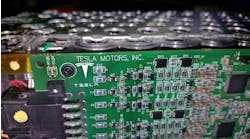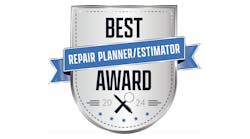Content brought to you by Auto Body Repair Network. To subscribe, click here.
One of the hottest topics in the auto collision repair world over the last five years surrounds the importance of pre-and post-repair scanning. Even so, industry reports reveal that as many as 70 percent of repair estimates do not have pre-and post-scans written into them.
I-CAR’s Technical Products and Curriculum subject matter experts (SMEs) discuss how there’s much more to this topic than simply pre-and post-scanning; it’s really about overall vehicle diagnostics and finding all of the collision damage.
SMEs representing approximately 105 years of combined experience on I-CAR’s Technical Products and Curriculum team led by Jeff Poole, Manager, include: Jason Hauboldt, Senior Associate, SME & Collision Repair Tech; TJ O’Rourke, Senior Associate, SME & Collision Repair Tech; and Anton Verwijst, Senior Associate, SME & Collision Repair Tech.
What can we do to underscore the importance of pre and post scanning?
Poole: I-CAR has been at the forefront in stressing this, including creation of our industry vetted I-CAR Best Practices, which is available at www.i-car.com/rts. You need to do this on every vehicle in the shop unless you are working on antiques, not just because of ADAS or some other new, advanced system. That’s the only way you’re going to find all the damage.
O’Rourke: I feel like it's almost like a broken record, we've been saying this for so long. When you get a car in, the pre-scan tells you the condition the vehicle is in when it arrives. The pre-scan also helps you identify any type of Diagnostic Trouble Codes (DTCs) that might be present, any potential problems with the vehicle before you do any disassembly and start repairing the vehicle where you might introduce additional codes. Understanding what you had at the beginning and what you've got at the end is what it’s all about, and also what you need to be concerned about.
What challenges or common reasons do technicians have for not conducting pre and post scanning?
Hauboldt: One of the most common reasons we hear is that they don’t have the proper equipment in the estimating bay or tear down area. You need to have the equipment and perform a scan when writing the estimate or blueprinting the repair. If you don’t have the equipment or have to chase down the scan tool from somewhere in the shop, chances are the vehicle is not getting scanned. Shops should develop an SOP to ensure every car gets a pre and post scan right at the beginning and end of the repair process. There's a lot of opportunity to incorporate scanning into the repair process and the shop’s SOP’s.
How important is detailed documentation in supporting pre and post scans?
Verwijst: When the repair is completed you need to have documentation surrounding all the things you did. In the collision world, we’re introducing a lot of DTCs in our repair process because the car goes into the booth and everything is torn apart. Especially for makers like BMW and Mercedes, they don’t like things unplugged while you’re moving the vehicle around the shop. So, you might be doing pre and post-scans multiple times, and you can’t just clear out codes each time. You have to know the codes you can clear out at the end of the repair, as well as the ones telling you, “Hey, there is still something wrong.”
Are pre and post scans important for high voltage vehicles?
Poole: Definitely! Electric vehicles bring additional safety considerations to the shop environment—let’s say an EV (or hybrid) comes into the shop with unknown issues related to the HV battery, cooling system, or other HV system components. While these vehicles are engineered with a multitude of safety features and redundancies there is still risk involved. Lithium-based batteries, for example, contain materials that could create a chemical reaction, resulting in a fire if a cell is compromised or unstable, it only takes one to start a domino effect. Damage to HV system wiring or modules could present a shock hazard to untrained personnel. So scanning is critical. Are there any HV system fault codes? What is the state of charge, cell balance, and internal battery cell pack temperature readings? All strong indicators of battery health.
And you have to think of the safety for shop staff, as well. Without scanning, how do you know where potential trouble lies?
O'Rourke: Scanning is really the starting point for all vehicles. When a car arrives a thorough inspection is a must. Perform your walk around, and document any damage that is present, and where in relation it is to HV components. The next step would be to check all the systems. You connect the vehicle specific scan tool up, and check for any active fault codes as well as check the live data regarding the HV system such as battery temperature and the voltage balance between cells. I also want to make everybody aware to go a step further in reading and understanding those measurements about the battery system and see those values and make certain everything is safe. That is super important before allowing a damaged HV vehicle into the facility.
Often when scanning, an NASTF (National Automotive Service Task Force) Vehicle Security Credential (VSC) is required. What is this and why is it necessary?
Verwijst: There are scenarios where to have a factory scan tool for in-shop purchase, you have to have a VSC. Several brand manufacturers are now requiring this. Additionally, some Ford vehicles now require that when you do an ADAS calibration, you need to enter a VSC. Even to replace car keys, there are many brands that require a security operation, a secure data release model with key codes. Procedures differ, especially with Mercedes-Benz, which has a program they call “theft relevant parts.”
Hauboldt: That’s right. For example, in collision damage where the steering column has been affected in some way, there are components of the steering column that will require replacing.
Those parts are considered “theft relevant parts” on most models. And to buy those parts, you have to have a VSC.
Key making is also changing too, which is another reason to have access to a VSC. Traditional keys that are cut by a machine are becoming a thing of the past. They are for emergency lockout now. Their only function is to go in that door, turn, and unlock it. Keys are now transponders. They're devices that communicate with the modules in the car saying, "Yeah you're my key, I'll let you in. I'll turn on." So that's why it’s not so easy to just get a key anymore.
Any final words?
Poole: There’s a lot of talk about blueprinting in the industry and rightfully so. If you're going to do a complete tear down, how is scanning not part of your process to look at the health of all the electronic systems? So, if you're not doing a pre-scan, you're setting yourself up for failure right out of the gate with possible delays later in the repair process and if you are not doing post-scans then you may be delivering vehicles with unknown problems which can lead to comebacks, or worse.
I don’t understand why there's any debate on this. I think part of the problem is that we've been having the wrong conversation of pre and post-scan notes. Beyond the actual scan it requires a knowledgeable technician to sort through the data, it's really vehicle diagnostics, finding all the damage, repairing it properly, validating and documenting repairs so you can deliver the vehicle with confidence!
For the most up-to-date information surrounding pre and post-scan repairs, go to www.i-car.com/rts.


